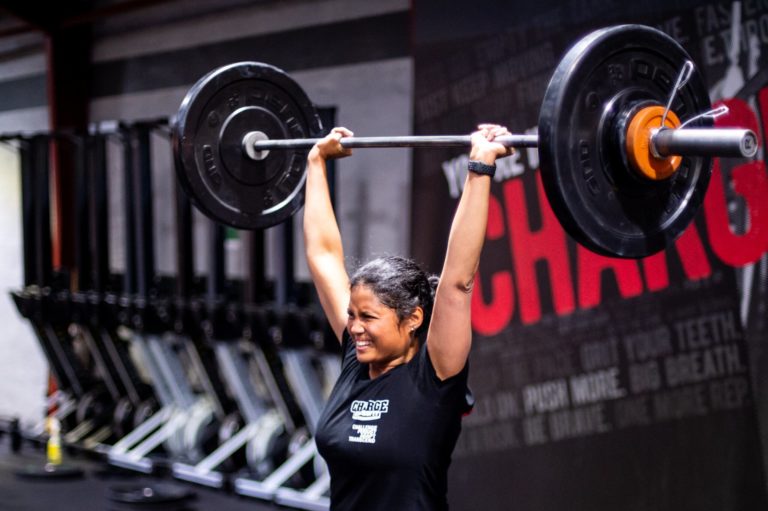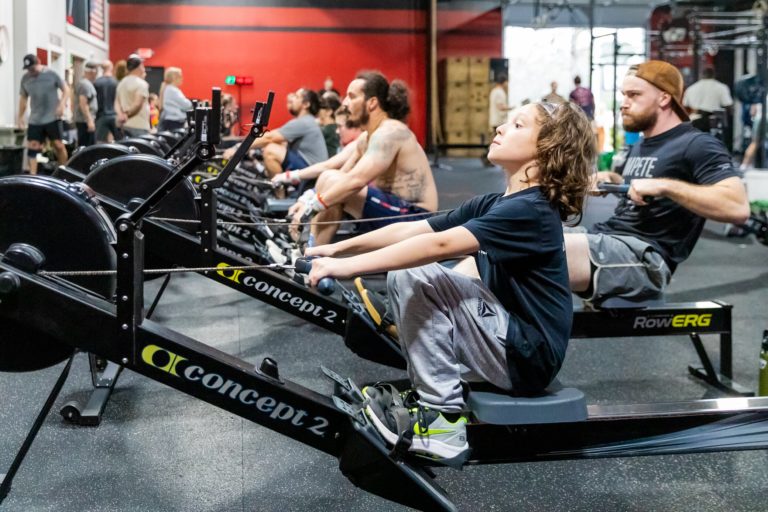Short Answer: It depends. Age, fitness level, and experience are important factors to consider. As a starting point, less is more and you can ramp up from there. The good news: CrossFit is easily adapted to meet the goals, needs, tolerances, and schedule of any individual at any age or fitness level.
If you’re new to or curious about CrossFit, you might be wondering how often you should work out.
Perhaps you’ve even come across some of CrossFit’s materials on the subject matter, such as “World-Class Fitness in 100 Words,” which advises us to train five or six days per week. Or maybe you’ve read that “world-class age-group strength and conditioning is obtainable through an hour a day six days per week of training.”
And perhaps that sounds intimidating — especially if you’re new to working out and/or are more interested in getting and staying healthy than being a “world class” athlete.
But the good news is the same method that results in world-class athletes is easily adapted to meet the goals, needs, tolerances, and schedule of any individual at any age or fitness level — and it will do so more safely and effectively than any other exercise program out there.
You may have heard of government recommendations that adults get 150-300 minutes of moderate-intensity aerobic physical activity or 75 minutes of high-intensity aerobic activity per week. These sources also suggest incorporating muscle-strengthening exercises in addition to limiting the amount of time spent sedentary.
But for the average person, these recommendations may yield more questions than answers:
If I do a warm-up, does that count toward my minute tally? Where does “moderate intensity” stop and “high intensity” begin? And which one is strength training? Can I do all 150 minutes at once, or should I spread them out evenly over the week?
In CrossFit, we don’t worry too much about how many minutes of exercise we accumulate.
 “Those are general guidelines,” said Eric O’Connor, Certified CrossFit Level 4 Coach (CF-L4) and CrossFit Seminar Staff Trainer, of the government recommendations. “And I think our general guideline is ‘let’s work pretty hard, consistently,’ and regardless of what the minutes turn out to be, the results will happen.”
“Those are general guidelines,” said Eric O’Connor, Certified CrossFit Level 4 Coach (CF-L4) and CrossFit Seminar Staff Trainer, of the government recommendations. “And I think our general guideline is ‘let’s work pretty hard, consistently,’ and regardless of what the minutes turn out to be, the results will happen.”
Most people can work at high levels of intensity — relative to their own fitness and experience — for three consecutive days before requiring a day of rest. A version of this cadence featuring five total training days and two total rest days per week — 3 days on, 1 day off, 2 days on, 1 day off, for example — allows for a consistent weekly workout schedule, may better fit the typical work and school schedule, and is highly effective for most people.
But this recommendation doesn’t mean you need to start straight out of the gate doing CrossFit five or six days per week — especially if you’re new to exercising.
“We’re going to err on the side of less is more and ramp it up from there,” O’Connor said.
If you’re just beginning your CrossFit journey, attending class two to three times per week can be a great place to start.
“Initially, you can see results with two days a week,” O’Connor continued, “(because) for most people, they’re getting exposed to movements, ranges of motion, loads, and effort levels they never really have been exposed to before.”
Depending on your skill and fitness level at the beginning, you may see consistent results at this cadence for a long time to come.
“But there will be a point in time where, especially (at) two times a week, that progress is going to plateau quicker than someone that has the commitment to come three to five times a week,” O’Connor said.
Just as important as figuring out how much to train is how much to rest. At worst, training too much could lead to injury; at best, burnout — and we want you doing CrossFit for the long haul.
Soreness — especially if you’re new to CrossFit — is normal. But prolonged or unexpected soreness, O’Connor said, could be a sign to take a break.
“I think a big telltale one is if you kind of leave (the gym) a couple days consistently being like, you know what, I didn’t really perform the way that I want to … and you didn’t think you really did a good job that day relative to your current abilities, I think that’s a sign of like, ‘Hey, let’s back off.’”
And if you’re new to CrossFit but perhaps not new to exercise, avoid the trap of trying to outtrain your fatigue.
“Some people might see a decline in performance and have the opposite mindset, like, ‘Hey, I gotta train more,’” O’Connor said. “When really, for a lot of people, I think the opposite is true.”
As CrossFit founder Greg Glassman wrote, “The needs of an Olympic athlete and our grandparents differ by degree, not kind.” We all need to lift things and move our bodies through space safely and effectively.
But how do we apply that to training frequency? If you’re starting CrossFit at 60, how often should you come to the gym?
“I use a similar approach for all age groups,” O’Connor said. “That crawl-walk-run approach.”
For this population, paying attention to how the body is feeling is even more critical, says Becky Harsh, CF-L4 and CrossFit Seminar Staff Trainer.
Harsh, on the cusp of 50 herself, recommends older athletes train three to four days per week.
“I absolutely think that movement five to six days per week is super important,” she said, “but those other days, I focus on things like going for a walk.”
Older athletes new to CrossFit should communicate with their coaches, Harsh said, and pay close attention to how well they recover between sessions.
“CrossFit is supposed to add to your life versus detract from your life,” she said. “Being sore is OK … but if you are the kind of sore that keeps you from doing other things that you would want to do or normally do, then that’s too much; you need to scale back either on the number of times you go to the gym per week or the volume or intensity you put in while you’re there.”
Especially for this demographic, it’s important to be flexible. There’s no need to force yourself to the gym four days a week just because that’s the schedule you set for yourself. Instead, consider the broader context.
“How am I feeling?” Harsh said. “What does the workout look like? What have I done the rest of the week? What have I got coming up for the weekend?”
She continued:
“Again, it comes back to CrossFit has got to add to my life. It can’t take away from my life.”
On the other end of the spectrum, you’ve got kids. CrossFit is an excellent way to promote physical, social, and cognitive health in children while instilling a lifelong love of fitness.
But how much is enough? Too much?
It depends on age, said Nickolas Pappas, Certified CrossFit Level 3 Trainer and CrossFit Seminar Staff Trainer.
Toddlers and elementary-schoolers — whose workouts are structured as games — can do as much CrossFit as they like.
“If you’re 3 years old and it starts getting hard, you’re going to stop,” he said. “So we’re not too worried about them overtraining.”
 The tween and teen age, Pappas continued, requires a little more nuance. Well-intentioned parents can make the mistake of turning the gym into a chore.
The tween and teen age, Pappas continued, requires a little more nuance. Well-intentioned parents can make the mistake of turning the gym into a chore.
“Then we may have made it so that they don’t want to continue to do CrossFit,” he cautioned.
For that reason, he recommends three to four days of CrossFit per week. Additionally, parents should be mindful that many preteen and teenage kids are active in sports outside of CrossFit. In those cases, two to three days of CrossFit per week is a great supplement to sport-specific training.
Regardless of age or experience, deciding how often to train comes down to key things, O’Connor said: Goals and longevity. What are you training for — the CrossFit Games? To keep up with your kids? Stay out of the nursing home?
And can you stay consistent with how you’re training “for 12 years and not just for 12 weeks?” O’Connor asked.
“Because we are going for the long haul of progress.”
How Often Should I Do CrossFit?